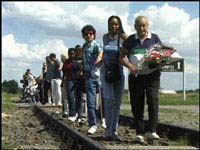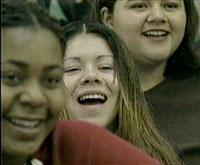




|

Freedom Writers
 |
The following page describes the Freedom Writers feature documentary as originally
seen and filmed by Wadirum (Roko & Adrian Belic) and Little Dust Productions. For any inquiries
about the documentary, please contact
The Freedom Writers Foundation.
Room 203 was a ghetto within a school,
a place with gangs, guns and nonexistent expectations. Room 203 became the
site of an academic miracle, a place where the wider world was suddenly real
and relevant to the students, where dazzling success was the norm and where
the students were motivated to give back to society. This is a story about
one maverick teacher and a group of teenagers who overcame the odds. Our film
is prompted by asking: "Why does the world's richest eco ettle for a poor education
system?" And, more importantly, "How can we change that?" This film points to one
classroom where answers were found. |
|
 Holocaust survivor Mel
Mermelstein
Holocaust survivor Mel
Mermelstein
shows students the tracks to Birkenau
|
Summary:
"Freedom Writers" tells the tale of an extraordinary high school class who, by learning about World War
II, broke a cycle of violence and failure in their inner city. It shows how one teacher transcended
deep-rooted prejudice and a struggling education system with reading, writing, energy and genuine faith in
her students. Picture an anonymous segment of 90s American urban sprawl. Homicide rates soar.
High school kids bus in from surrounding ghettos where many expect to die in gang-related conflict before
graduation. But something very unusual happens: a new teacher inspires them to take pleasure in
learning. And in living. She does this by introducing them to history and the joy of reading - not just
the mechanics of it, which is a struggle for some - but also the art of writing and the intense impact
of creatively expressing their experiences, and their soul. Today, "Ms. G's kids" are in college and have
jobs they'd never dared to dream about. They've published a book, traveled the world and brought members of
Congress to tears and a standing ovation. Their journey from despair to hope lies at the heart of this
personal and national drama and is the central theme of our film.
Background:
The story begins in 1994 when freshmen at a Long Beach high school are assigned to an English class
for "problem kids." Darrius is on parole. Henry is dealing crack.
 Gang membership is the norm in this class of mainly poor and non-white kids.
An unlikely new teacher walks in wearing a preppie suit and pearls. Erin Gruwell is fresh out of teacher
training and tries to do her job with calm and patience. But just days later, she flies off the handle.
She actually screams at her startled students. Her outburst is not due to the rowdy inattentiveness of
Room 203. She has intercepted a note of a sketched black face with cartoon lips. Infuriated, Ms. Gruwell
yells that this is the kind of stereotyping that led to the Holocaust. The students respond with blank
stares. Her students have never heard of the Holocaust. She asks how many have been shot at for belonging
to a "wrong" group. Nearly everyone in the class raises a hand. This is when "Ms. G." decides to deviate
from the curriculum. Gang membership is the norm in this class of mainly poor and non-white kids.
An unlikely new teacher walks in wearing a preppie suit and pearls. Erin Gruwell is fresh out of teacher
training and tries to do her job with calm and patience. But just days later, she flies off the handle.
She actually screams at her startled students. Her outburst is not due to the rowdy inattentiveness of
Room 203. She has intercepted a note of a sketched black face with cartoon lips. Infuriated, Ms. Gruwell
yells that this is the kind of stereotyping that led to the Holocaust. The students respond with blank
stares. Her students have never heard of the Holocaust. She asks how many have been shot at for belonging
to a "wrong" group. Nearly everyone in the class raises a hand. This is when "Ms. G." decides to deviate
from the curriculum.
The teenagers begin to read books by people their own age, people living in war zones. Ms. G. assigns
"The Diary of Anne Frank", "Zlata's Diary: A Child's Life in Sarajevo", and other literature
that presents parallels to the students' world. They begin to keep their own diaries. GPA's soar from 0.5 to
4.0 and word gets around school that the remedial students are having fun. Ms. G's course becomes the most
popular at Wilson High.
The enthusiasm is infectious. Ms. G. starts moonlighting as a hotel concierge and as a lingerie saleswoman
at Nordstrom for money to buy books and take the kids on field trips. They visit the Tolerance Museum and
go to see "Schindler's
 List."
With a sponsored Read-a-thon, the class raises funds to invite Miep Gies, the Dutch woman whose attic
sheltered Anne Frank. Gies says that the ghettos where the students live are America's own war zones.
She calls the students heroes. Other authors and luminaries come to visit. Over time, the students
forge a strong bond and dub themselves the "Freedom Writers" (in homage to the Freedom Riders civil
rights activists). List."
With a sponsored Read-a-thon, the class raises funds to invite Miep Gies, the Dutch woman whose attic
sheltered Anne Frank. Gies says that the ghettos where the students live are America's own war zones.
She calls the students heroes. Other authors and luminaries come to visit. Over time, the students
forge a strong bond and dub themselves the "Freedom Writers" (in homage to the Freedom Riders civil
rights activists).
Erin Gruwell and her students don't want to be separated at the end of the first year, so they convince
the school to let her keep teaching them as well as taking on a new class. Over time the group swells to
150 Freedom Writers. Their profile is so impressive that a local businessman sponsors 60 students and Ms. G.
on a trip to Europe. At Auschwitz they are moved by the stories of Holocaust survivor Mel Mermelstein, who
shows them around the camp where he was held. They also visit Anne Frank's attic, Sarajevo, and other
conflict zones. "Tolerance" takes on a whole new meaning for these teenagers. On the other side
of the world, they find they share stories of guns, prisons, anger and survival.
As they return to America, Doubleday publishes a volume of their journals: "The Freedom Writers Diary
- How a Teacher and 150 Teens Used Writing to Change Themselves and the World Around Them." The class
of "problem kids" begins a national book tour. In a school where only half the students typically
go to college, every "Freedom Writer" graduates.
They all get into college and they get jobs. Now, with a book, a mentor program, speaking engagements and
a possible fiction film, these young people relish the opportunity to inspire their peers. They are a
beacon of light to many who have nearly given up hope. They spread the message: you don't have to wait
for the government to change the system, it just takes pooling of available resources.
Quotes:
"A couple of days ago one of my friends was laid
to rest. His funeral was just like any other. Family members were crying. His friends were swearing that
they would get revenge."
- Diary 6, from The Freedom Writers Diary
| |
|
| |
"When I started writing I started uncovering the
truth that I always knew but I didn't really know as a person that I experienced it. ...I was
realizing more about my past."
- George A., on the effect of keeping a
diary with the Freedom Writers
|
A few months after this photo, Tony was severely beaten
by black kids while jogging a few blocks out of his primarily Hispanic neighborhood. Left for dead,
his nose and jaw broken so badly that he had to have his mouth wired shut for weeks, he said,
"I don't want to take revenge. I feel sorry
for those guys because they probably have very little to look forward to in life. They're stuck in
the ghetto and I'm free." Tony continued living in the ghetto
with his family. He is an aspiring filmmaker and worked as a Production Assistant on this film.
|
 |
"Ms. G was the first person to ever
believe in me, so I couldn't let her down. When my dad saw me reading and getting excited about
school he started taking night classes. After a few months he quit his gang and said he was starting
a new life."
Production:
This feature documentary was completed by Live Planet Productions who collaborated with the Freedom Writers Foundation
It was originally produced by Little Dust Productions and Wadirum, directed by Roko Belic.
Filmmakers:
This feature documentary was completed by affiliates of the
Erin Gruwell Education Project.
It was originally produced by Little Dust Productions and Wadirum, directed by Roko Belic with his brother
Roko and Adrian Belic came to this project
straight from the success of their first film "Genghis
Blues" (Oscar nominee in 2000 and winner of 1999's Sundance Audience Award and many others around the
world). Director Roko Belic says the ghettos of Long Beach remind him of the gritty neighborhoods that
surrounded his Chicago high school. His empathy may be one reason why the kids welcomed him and his brother
and opened up to them. The Belic brothers partnered on this film with producer
Jasmine Dellal, whose film
"American Gypsy" aired in the 2000 season of
PBS's prestigious POV series after an arthouse theatrical release and a successful run in festivals, where
it won a number of international awards, and continues to be shown at educational and grassroots screenings.
This is a story about teenagers who passionately grasp a chance to grow and express
themselves, and a teacher who learned with them how to teach them. The setting for these transitions
is a national education system with a lot of problems, but where success is still possible. These sad
conditions are all too familiar, but the individuals are truly exceptional and brave. And although this
success story cannot be cloned, it has elements that can be applied beyond the poorest classrooms of Long
Beach to struggling students everywhere.
© Little Dust Productions, All Rights Reserved
|
Last Updated: January 2022
|
|
 |
|
